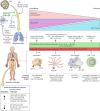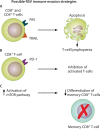The Human Immune Response to Respiratory Syncytial Virus Infection
- PMID: 28179378
- PMCID: PMC5355638
- DOI: 10.1128/CMR.00090-16
The Human Immune Response to Respiratory Syncytial Virus Infection
Abstract
Respiratory syncytial virus (RSV) is an important etiological agent of respiratory infections, particularly in children. Much information regarding the immune response to RSV comes from animal models and in vitro studies. Here, we provide a comprehensive description of the human immune response to RSV infection, based on a systematic literature review of research on infected humans. There is an initial strong neutrophil response to RSV infection in humans, which is positively correlated with disease severity and mediated by interleukin-8 (IL-8). Dendritic cells migrate to the lungs as the primary antigen-presenting cell. An initial systemic T-cell lymphopenia is followed by a pulmonary CD8+ T-cell response, mediating viral clearance. Humoral immunity to reinfection is incomplete, but RSV IgG and IgA are protective. B-cell-stimulating factors derived from airway epithelium play a major role in protective antibody generation. Gamma interferon (IFN-γ) has a strongly protective role, and a Th2-biased response may be deleterious. Other cytokines (particularly IL-17A), chemokines (particularly CCL-5 and CCL-3), and local innate immune factors (including cathelicidins and IFN-λ) contribute to pathogenesis. In summary, neutrophilic inflammation is incriminated as a harmful response, whereas CD8+ T cells and IFN-γ have protective roles. These may represent important therapeutic targets to modulate the immunopathogenesis of RSV infection.
Keywords: immunology; respiratory syncytial virus.
Copyright © 2017 American Society for Microbiology.
Figures






References
-
- Welliver TP, Garofalo RP, Hosakote Y, Hintz KH, Avendano L, Sanchez K, Velozo L, Jafri H, Chavez-Bueno S, Ogra PL, McKinney L, Reed JL, Welliver RC. 2007. Severe human lower respiratory tract illness caused by respiratory syncytial virus and influenza virus is characterized by the absence of pulmonary cytotoxic lymphocyte responses. J Infect Dis 195:1126–1136. doi:10.1086/512615. - DOI - PMC - PubMed
-
- Heidema J, Lukens MV, van Maren WWC, van Dijk MEA, Otten HG, van Vught AJ, van der Werff DBM, van Gestel SJP, Semple MG, Smyth RL, Kimpen JLL, van Bleek GM. 2007. CD8(+) T cell responses in bronchoalveolar lavage fluid and peripheral blood mononuclear cells of infants with severe primary respiratory syncytial virus infections. J Immunol 179:8410–8417. doi:10.4049/jimmunol.179.12.8410. - DOI - PubMed
Publication types
MeSH terms
Substances
Grants and funding
LinkOut - more resources
Full Text Sources
Other Literature Sources
Medical
Research Materials
Miscellaneous

